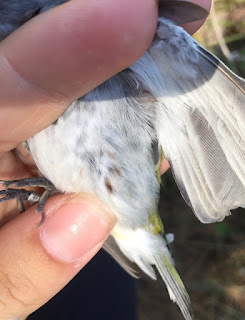Despite closing a few nets early and coping with strong winds throughout the morning, we still managed to finish the day with 60 new birds and 19 recaps. Interestingly, our 19 recaps included 13 different species, while the 60 new birds were only comprised of 11 species.
Our most interesting bird of the day was a hatch-year Acadian Flycatcher, a species of Empidonax flycatcher. Empids are notoriously difficult to identify, even in hand. The easiest way to distinguish an Acadian Flycatcher from a "Trail's" Flycatcher, which we catch many more of, is to examine the color of the bird's legs. Acadian Flycatchers have a gray leg, while "Trail's" Flycatchers have a dark gray-to-black leg. Like I said, notoriously difficult.
 |
| Hatch-year Acadian Flycatcher, Sex unknown. The feet still appear dark in this photo but the legs were significantly lighter in person. |
Little Bear
Little Bear started out the day with all of the nets open. As the morning went on, the wind gradually picked up forcing us to close certain nets. By the ten o'clock hours most of the nets were being blown around, causing us to close early.
Little bear caught 49 new birds and 6 recaptures. We had 12 species of previously unbanded birds and 4 species of recaptures.
The highlight of the day was this leucistic Common Yellowthroat.
 |
This was a hatch-year male. You can still see
the cool looking A1 molt limit!
|
-Paul
| Species | Captain Sam's | Little Bear | ||
|---|---|---|---|---|
| New | Recaps | New | Recaps | |
Common Ground-Dove
|
-
|
1
|
-
|
-
|
Downy Woodpecker
|
-
|
1
|
-
|
-
|
Acadian Flycatcher
|
1
|
-
|
-
|
-
|
White-eyed Vireo
|
-
|
-
|
-
|
1
|
Red-eyed Vireo
|
5
|
1
|
1
|
-
|
Carolina Chickadee
|
1
|
1
|
-
|
-
|
House Wren
|
-
|
-
|
3
|
-
|
Carolina Wren
|
-
|
-
|
-
|
1
|
Swainson's Thrush
|
1
|
-
|
-
|
-
|
Gray Catbird
|
8
|
4
|
2
|
-
|
Brown Thrasher
|
-
|
1
|
-
|
-
|
Northern Mockingbird
|
-
|
1
|
-
|
-
|
Northern Waterthrush
|
2
|
-
|
3
|
-
|
Black-and-white Warbler
|
1
|
-
|
1
|
-
|
Common Yellowthroat
|
33
|
2
|
28
|
3
|
American Redstart
|
3
|
2
|
1
|
-
|
Cape May Warbler
|
-
|
-
|
1
|
-
|
Northern Parula
|
-
|
-
|
1
|
-
|
Yellow Warbler
|
3
|
1
|
-
|
-
|
Black-throated Blue Warbler
|
-
|
1
|
-
|
-
|
| Palm Warbler (western) | 2 | - | 6 | - |
| Prairie Warbler | - | - | 1 | - |
| Northern Cardinal | - | 1 | - | 1 |
| Indigo Bunitng | - | - | 1 | - |
| Painted Bunting | - | 2 | - | - |
| Banding Stats | Captain Sam's | Little Bear | TOTAL |
|---|---|---|---|
| # Birds Banded |
60
|
49
|
109
|
| # of Recaptures |
19
|
6
|
25
|
| # of Species |
18
|
15
|
25
|
| Effort (net-hours) |
117.6
|
61.4
|
178.6
|
| Capture Rate (birds/100 net-hours) |
67.2
|
89.6
|
75.0
|
| # of Nets |
26
|
20
|
46
|
Banding Staff
Aaron Given (CS)
Mattie VandenBoom (LB)
Michael Gamble (LB)
Kristen Oliver (CS)
Brandon Connare (CS)
Paul Carroll (LB)
Hannah Conley (CS)
Ryan Donnelly (CS)




























